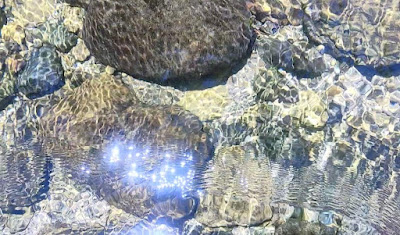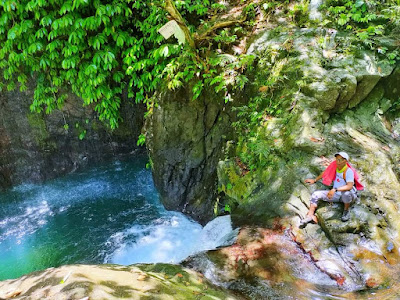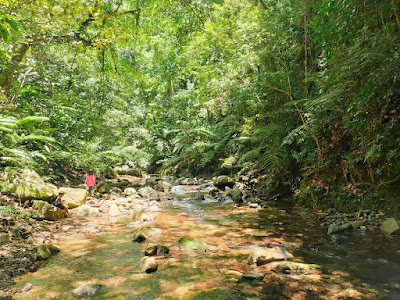This is the story of how I accidentally wandered into the easternmost seaboard of the Philippines, outside my planned itinerary. A kind Samaritan came to my rescue.
 |
| Davao Oriental, the easternmost province of the Philippines |
Backpacking is not easy. You must plan your itinerary yourself, from transportation to selecting hotels and destinations. While numerous affordable travel agencies can organize your tours, I have always preferred the DIY approach. It allows me the freedom to explore without the pressure of time constraints that often accompany organized tours. Moreover, traveling independently fosters courage, resourcefulness, and adaptability, providing opportunities to learn something new and challenging.
However, there is a significant downside to DIY travel: the commuting issues. This led to my unforgettable story of courage, decision-making, and quick thinking.
 |
| Mount Apo as seen from Samal Island, Davao Del Norte |
On Day 1, my original plan was to conquer Mount Apo in Davao Del Sur, the highest peak in the Philippines at nearly 3 kilometers above sea level. Climbing it would take three days, consuming half my week in the "Land of Promise." Therefore, I switched to Plan B: exploring the natural richness of Mount Hamiguitan, a UNESCO World Heritage Site known for its incredible biodiversity.
Mount Hamiguitan is located on the southernmost tip of eastern Mindanao in Davao Oriental, about a six-hour bus ride from Davao City. It straddles the administrative boundaries of Mati City, San Isidro, and Governor Generoso. However, I soon faced my first challenge: climbing Mount Hamiguitan requires a minimum of 20 hikers, even with a guide. To reach the peak, you must stay at base camps for at least two days to fully appreciate the mountain's grandeur. This experience taught me that no mountain can be tamed easily. You must study and respect their majesty, as these mountains are the crowning glories of Mindanao.
Consequently, I redirected my efforts toward Aliwagwag Falls, the longest and highest waterfall in the Philippines, composed of numerous powerful cascades that create a perpetual mist. Unfortunately, there was only one direct bus from Davao City to Aliwagwag at 2:00 AM, which was impractical after a long day. I chose to take a bus at 7:00 AM instead.
I took a dilapidated bus from Davao City Ecoland Terminal to Compostela Valley, Davao De Oro Province. The journey was grueling, lasting nearly seven hours. By 2:00 PM, I arrived in Compostela, looking haggard. Once again, I faced a lack of public transport to Aliwagwag, so I had to hire a habal-habal (a motorcycle taxi). The fare of 800 pesos for a one-way trip felt like a rip-off, but with no alternatives, I accepted his "take it or leave it" condition, despite the rain pouring down.
 |
| The beauty of Mindanao Island |
Along the way, I found some consolation in the breathtaking beauty of the Mindanao valleys, cloud-covered mountains, and lush tropical rainforests, dotted with hidden waterfalls along the winding road. After a back-breaking three-hour ride, I finally reached Aliwagwag Falls.
The falls were astonishingly powerful, unlike anything I had ever seen. Named after a remote village in Cateel (pronounced as ka-TE'-el), Davao Oriental, it is the country's highest waterfall. Aliwagwag Falls is a protected landscape rich in biodiversity situated in the Eastern Mindanao Biodiversity Corridor, containing one of the largest remaining blocks of tropical lowland rainforest in the Philippines and home to the endangered Philippine eagle and the tallest trees in the country, the Philippine rosewood, known locally as "toog". There in my way, tons of logs and lumber could be found.
 |
The massive force of the Aliwagwag Falls
|
I intended to spend the night at Aliwagwag but discovered, due to inadequate research, that the park had been closed for renovations since the start of the COVID-19 pandemic, and swimming was prohibited. With no cellphone signal, no data, and no transportation options, I felt frustrated, my heavy hiking gear rendered useless. Fortunately, sightseeing and photography were allowed.
As dusk approached, I sought refuge in a small coffee shop near the falls while waiting for a ride to Cateel, where I hoped to find a hotel for the night. After an hour of waiting with no success, I learned from a vendor that no regular vehicles were plying the area. Desperation set in, and I considered the possibility of sleeping in a waiting shed, as there were no nearby homes.
Should I have awkwardly asked the vendor if I could stay at her home? I silently prayed for help.
Just then, a meat delivery truck from Compostela pulled into the coffee shop. Two men got out and ordered durian coffee and baguettes. After their break, I humbly asked if I could hitch a ride with them to Cateel. To my relief, the younger man, RJ Lumpas, agreed.
RJ and his father drove me as far as the crossing to Cateel since they were headed to Baganga, which lies to the south. From the crossing, I wasn't sure if any habal-habal or tricycles were available to take me to Cateel, especially since it was already late afternoon and the area was sparsely populated.
 |
| Pilot's View Beach in the town of Baganga |
"Why not come with us to Baganga?" RJ suggested. "There are hotels there, and many more places to visit than in Cateel."
After considering the situation, I decided to trust RJ and his father and accepted their offer. I learned much about life in Mindanao from RJ, who had never been to Manila or Luzon. I expressed my gratitude, telling him he had saved me from a difficult situation. He assured me that helping those in distress is a common value among his community.
To make the most of my time, RJ stopped at Ban-ao Beach, the second easternmost point in the Philippines, where we enjoyed a stunning view of the Pacific Ocean and a serene islet.
 |
| Ban-Ao Beach, facing the tide line of the Pacific Ocean |
After nearly two hours of winding roads, we arrived at RJ and Jane Meat Shop, where they delivered their products. Before parting ways, RJ contacted his friend, Nonoy Hapitan, to guide me the next day to various tourist destinations in Baganga. Nonoy, with his unique tricycle, took me to Habibi Pension House, about five minutes from the town center. I went to bed early, as I had a 2:00 PM bus to catch back to Davao City the next day.
 |
| Lake Carolina surrounded by mangrove forest |
At 7:00 AM, Nonoy took me to a local restaurant for breakfast, where I enjoyed balbacua, a hearty soup made from cattle skin. It was delicious, and I couldn't resist devouring two kilos of durian, which is rare and expensive in Luzon.
At Lake Carolina, I marveled at the lush greenery and mangroves surrounding the brackish lake, where the crystal-clear waters allowed me to see the limestone beds below. Being a thalassophile, I asked Nonoy to take me to the beach. We arrived at Pilots View Beach, a tranquil spot with immaculate white sand and turquoise waters. Gazing out at the vast Pacific Ocean, I realized that the Philippine Deep, one of the world's deepest trenches, lay just beyond.
 |
| The long stretch of uninterrupted white beach in Baganga |
Davao Oriental is the easternmost province of the Philippines, with Baganga being the second place in the country to greet the sunrise daily, next only to Pusan Point in the neighboring municipality of Caraga.
As we traveled, we stopped at San Victor Island, a small elongated sandbar resort, one of the 7,146 islands in the Philippines and a major tourist destination in Baganga. From the map, San Victor Island is actually the second easternmost island beach resort in the country next to the bigger Poo Sand Bar and Mermaid Atoll.
Sunrise Boulevard truly lives up to its name as the first boulevard in the Philippines to be kissed by sunlight. Compared to Manila's Roxas Boulevard, it is quieter, cleaner, and more natural. The shores are lined with white sand and mangroves, creating a stunning scene in the morning. Despite the devastation caused by a recent typhoon, which left some mangrove forests in ruins, the landscape was still breathtaking.
Since the eastern Mindanao faces the massive Philippine trench, a product of herculean geological forces that constantly happening within the Earth, it is no wonder that the area has numerous hot springs and vents serving as outlets from the heat within the Earth. The Balete Hot Springs at Kinablangan, in the municipality of Baganga offers such hot bath and pampering using the healing property of nature.
 |
| The pampering of natural hot springs in Kinablangan |
 |
Sunrise Boulevard at Brgy. Kinablangan
|
By 2:00 PM, it was time to catch the UV Express van back to Davao City. I couldn't afford to miss it, as it was my only means of transportation, and I had plans to visit Samal Island the following day. Although I wished I could have explored Baganga longer, I was grateful for my unexpected detour. This province, where the first sunlight of the day occurs, was a hidden gem I never expected to discover.
Reflecting on my journey back to Davao City, I realized how small our world is and how short our lives can be. We should strive to make our lives meaningful and uplift others as well. Kindness costs nothing, and we never know when we might find ourselves in need of help.
If you ever find yourself in Baganga, Davao Oriental, consider reaching out to Mr. Rex Guhayon (real name RJ Lumpas), owner of RJ and Jane Meat Shop, or Mr. Nonoy Hapitan, a local who became my guide during my adventure. They are friendly and willing to help, embodying the generosity that the region is known for.
More:
https://m.facebook.com/story.php?story_fbid=pfbid02Du3bvFoWGp6bGZZD5HB21MDkzs4FVTvkgubcVphE6wNtxJJjv4m4P61J2iXNajnGl&id=100007283687906&mibextid=Nif5oz
---
#ExplorePhilippines #Mindanao #TheLandOfPromise #WanderingStory #TravelDiary #bagangatourism #BagangaDavaoOriental #LoveThePhilippines



















































